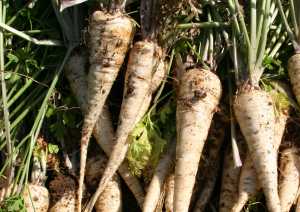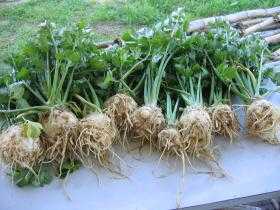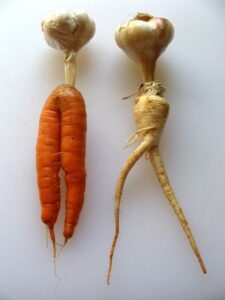It is almost time to celebrate the new year of the trees! Tu B’Shvat falls this year next Shabbat and Melissa of “Mipri Yadeha” is once again offering festive baskets of 100% fruit of the land, including of course her own dried fruit, carob pods, nuts, sun-dried raisins, Samar dates, and a special 4-flavor fruit leather sampler – 44 NIS per basket.
Also available in time for the holiday, raisins in kilo size at 36 NIS – sun-dried and with no preservatives.
_______________________________
Rooting for Winter
Last week, we were blessed with an extraordinary winter storm. Out of seven days, not one was dry. This last weekend was VERY cold, and we made sure to cover all the greens in agril (agricultural plastic sheeting) to protect them from the low temperatures. Meanwhile, those Chubeza residents quietly smiling to themselves were, of course, the root vegetables, from the depth of the earth as they basked under the insulated ground and its relative warmth, lapping up generous amounts of water (over 250 mm in just this one week!). This week’s Newsletter spotlights on the celery and parsley roots, who will be visiting your home this week.
Every plant needs roots and leaves, of course. The roots draw up the nutrients from the earth, and the leaves act as conduits to transform sunrays into available energy for the plant. This is why all parsley leaves have a root, and every parsley root has leaves (which look like… parsley, of course.) But not every parsley variety produces the root we call “root parsley.” The leaf parsley is satisfied with modest, thin roots and does not develop a thick root. The root parsley was developed over the years by farmers in the ongoing process of selecting preferred species and cultivating them. Thus, alongside the seeds kept from year to year from the plants boasting the biggest leaves or best taste or highest durability to extreme temperatures or pests, other seeds were kept as well– those of plants whose roots thickened. The “cultivated” result is the species we call “root parsley,” a savory delight to add to the soup. Today it is a totally different species than the parsley grown for its leaves.
The root parsley (also called Dutch Parsley, Hamburg Parsley, Rooted Parsley, Turnip-Rooted Parsley, Heimischer, Petoushka…) only grows in wintertime. Unlike its sister which grows leaves in summer as well–even under the scorching Israeli sun–the root parsley hates heat, and grows in winter’s low temperatures and high humidity. It also needs a lot more time to reach maturity. The roots appearing in your boxes were seeded in autumn and have been growing underground for some five months now (leaf parsley is ready in two to three months). The main challenge in growing it is the thinning-out process. This parsley’s elongated roots need space to grow and fatten up, so it’s crucial to thin the bed which was manually seeded and thus grows plants in dense proximity. When we thin them, we remove some of the young sprouts, allowing their siblings some more “growing space.” We do not always do this in time, and therefore we pack a bunch of some smaller parsnips in order to reach at a suitable-sized portion.
The celeriac is a cultivated species, like its brother the stalk celery, meaning it was cultivated over hundreds of years. Farmers sought its thickened root, selecting from season to season only the celery varieties which produced the chubbiest, biggest roots. In this case, the stems remained short and thin, with a taste far more prominent than that of stalk celery. Often the stems are hollow, like a straw. When you look at a bed of stalk celery alongside one of celeriac, it’s easy to identify them by the different way the leaves grow. The former are erect and long, the latter chubby and spread out.
Celery is a plant which grows slowly. It starts with its teeny, tiny seeds which take their time, two-to-five weeks, till they sprout. After their diminutive sprouting, they need at least another two months of devoted care in the warm, protected temperature of the plant nursery. Only after three months are they ready to be planted. We receive the young’uns when they’re approximately three months of age and ready to be lifted out of their black plastic cube and placed in the fertile earth of Chubeza’s field.
Celery loves fertile earth and lots of water. As a plant which originated in the swamps, it likes humidity in the earth and also in storage, which is why it grows in wintertime in Israel. The Israeli summer is difficult and dry for the crisp celery plant. After three months in the nursery, it needs another three months to reach the prime age at which its leaves and stems can be harvested. The species which develops a thick root is even more patient, waiting another month under the warm cover of Mother Earth and refusing to be coaxed out of its warm bed to the cold, raging winter. A simple calculation leads to the conclusion that the lovely celeriac visiting your boxes this week was created seven months ago!
And though its time has come, the celeriac still holds on to the earth with all its might, and is not easily convinced to emerge. When we harvest the celeriac, we use a knife and gently release it by cutting the surrounding slender roots. Upon retrieving it from the earth, we attempt to shake it well and cut off the remaining clumps of earth still caught within. After this initial cleansing, we lead it to our vegetable washing tubs where it soaks for a while. Even so, when it arrives, you may still see remains of dirt. Immerse in water for some 30 minutes to expedite the final cleaning.
So holding these two yummy roots in your palms, you must want to rush to the kitchen to prepare some soup. But wait! First have a look at this week’s recipes for delectable uses of these roots in a host of ways. A must!
Lastly, in honor of our distinguished root vegetables, I’m delighted to share this charming picture sent last year by Daniel from Modi’in. The caption read: “Do Chubeza vegetables have a secret, enchanted life, where they dance the night away?”
Wishing you a sunny, warm week,
Alon, Bat Ami and the Chubeza team
_________________________________________
WHAT’S IN THIS WEEK’S BOXES?
Last week’s frigid temperatures have caused a temporary shortage of cucumbers. Please bear with us…..
Monday: Celeriac or root parsley, white or purple cabbage, tomatoes, spinach/kale carrots, tatsoi, potatoes, fennel/kohlrabi, chives or scallions, coriander (small boxes only), cauliflower (small boxes only)
In the large box, in addition: Broccoli, leeks, daikon, beets, parsley
Wednesday: broccoli, cabbage, potatoes, turnips or kohlrabi, parsley root or celeriac, dill or parsley, red sweet peppers, lettuce, leeks or scallions, carrots, tomatoes
In the large box, in addition: cauliflower or beets, fennel, kale or spinach
And there’s more! You can add to your basket a wide, delectable range of additional products from fine small producers: granola and cookies, flour, sprouts, goat dairies, fruits, honey, crackers, probiotic foods, dried fruits and leathers, olive oil and bakery products too! You can learn more about each producer on the Chubeza website. On our order system there’s a detailed listing of the products and their cost, you can make an order online now!
______________________
Caramelized Assorted Root Vegetables
Parsley root fries with roasted tomatoes ketchup
Parsley root recipes from Mariquita farm
Smashed celeriac – Jamie Oliver
Celery root soup – David Labovitz
Roasted Celery Root with Maple Apple Butter – Emeril Lagasse, Planet Green
Turkish celery root (Kereviz Kökü) – inspired by the book “Anatolian Feast”



